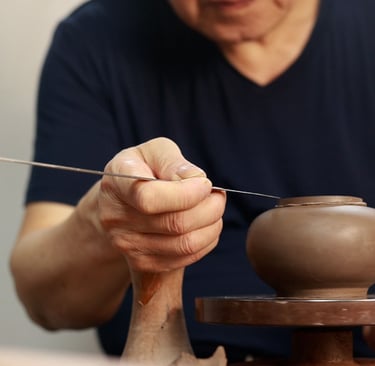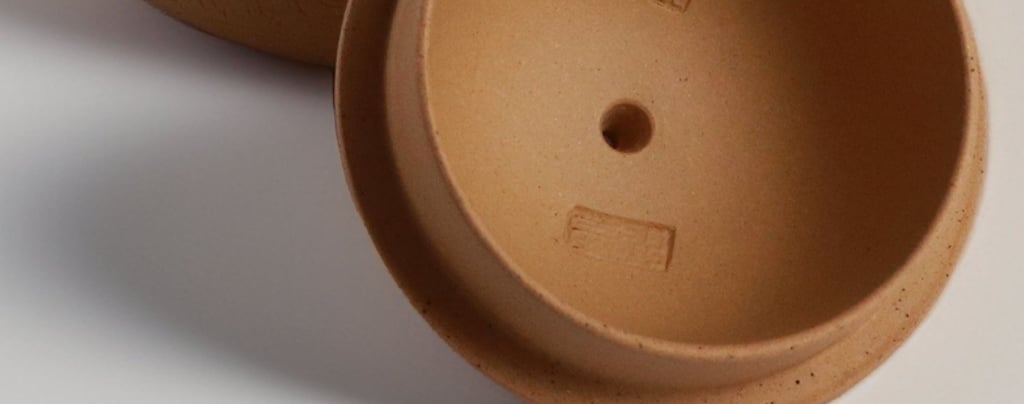Why Craftsmanship Matters in Luxury Tea Sets
Explore why craftsmanship elevates luxury tea sets beyond mere functionality. Discover the history, artistry, and uniqueness that make handcrafted tea sets highly collectible and culturally rich investments. From Yixing Zisha to Polish ceramics and Japanese wabi-sabi pottery, see how true craftsmanship transforms tea sets into timeless art.
TEA WARES GUIDE


Ever wondered why some tea sets feel more special than others?
Why are handmade tea sets so highly sought after?
Let’s dive in, because the value of a handcrafted tea set goes beyond just looking pretty on your shelf.
In this post, we’ll explore the history, uniqueness, and collecting potential of handcrafted tea sets.
And by the end, you'll see why craftsmanship matters in luxury tea sets.
Why Handmade Tea Sets Have More Collectible Value
A mass-produced tea set might look sleek, but it won’t have the soul of a handcrafted one.
When artisans shape each piece by hand, it means each tea set is unique.
This uniqueness adds intrinsic value, which is why handmade tea sets hold such appeal in the world of collectors.
The Characteristics of Handmade Tea Sets
What makes a handmade tea set stand out?
Unique artistry – No two handmade tea sets are identical.
Material choice – Often, higher-quality materials are used.
Personalisation – Many brands offer bespoke tea sets, tailored just for you.
These factors contribute to a one-of-a-kind piece that you can’t just grab off the shelf at any store.
Iconic Handmade Tea Sets from Around the World
When it comes to handcrafted tea sets, several traditions have stood the test of time, blending history with artistic mastery. Let’s explore three iconic styles—Yixing Zisha from China, Polish handmade ceramics, and Japanese wabi-sabi pottery—that continue to bring ancient techniques and modern design together in perfect harmony.
Polish Handmade Ceramics: A Touch of Europe
Poland’s handmade ceramic tea sets are world-renowned for their elegance and practicality.
They combine traditional techniques with modern design, creating beautiful yet functional pieces.
If you're looking for a tea set that blends history and culture, Polish pottery is an excellent choice.
Yixing Zisha: Ancient Craft Meets Modern Design
Yixing teapots are made from a unique clay found only in Yixing, China.
The craftsmanship here is legendary, with techniques passed down for generations.
Many consider these teapots the gold standard when it comes to handmade tea sets.
Their rustic, earthy look is perfect for the serious tea connoisseur.
If you're interested in high-end teapots, you can visit TeapotArtisan—true to its name, every teapot is crafted by skilled artisans.
Japanese Handmade Pottery: The Serenity of Wabi-Sabi
Japanese tea sets are famous for their understated beauty and Zen-like simplicity.
The Japanese take tea culture seriously, and every handmade piece reflects their deep connection with nature.
Japanese ceramicists often craft tea sets with a philosophy known as wabi-sabi – finding beauty in imperfection.
The result? A perfectly imperfect set that embodies tranquillity.
The Collecting Value of Handmade Tea Sets
Handmade tea sets aren't just pieces of art – they’re investments.
Here’s why:
Limited editions and uniqueness – No mass production here.
Market performance and potential for appreciation – These sets can increase in value over time.
Artistic merit – A well-crafted tea set is as much an investment in culture as it is in quality.
Collecting these tea sets is about more than just owning them – it's about preserving tradition, art, and craftsmanship.
For collectors, a carefully chosen set could be worth much more than its initial price down the line.
How to Buy Handmade Tea Sets
So, how do you make sure you're getting a real handmade tea set and not a cheap knockoff?
It’s all about knowing what to look for.
Identifying True Handcrafted Quality
Look for these signs to ensure your tea set is truly handmade:
Attention to detail – Imperfections are actually a sign of authenticity.
Craftsmanship – The quality of the material and the way it's worked tells you a lot.
Signature or mark of the artist – Genuine handmade pieces often have the artist’s mark, a symbol of quality.


Key Things to Keep in Mind When Buying
Material – Make sure the materials used are of high quality, like porcelain, clay, or stoneware.
Authenticity – Research the maker and the history of the tea set.
Functionality – Handmade doesn’t mean fragile. Choose a set that feels sturdy and practical, not just decorative.
Conclusion
Handmade tea sets carry more than just sentimental value – they’re a celebration of culture and craftsmanship.
The beauty lies in the imperfection, the uniqueness, and the history behind every piece.
These sets transcend being just functional items; they represent art, culture, and personal expression.
In the world of luxury tea sets, craftsmanship isn’t just important – it’s what makes these sets truly priceless.
If you're interested in exploring more about luxury teapot brands, feel free to visit our website for additional insights.
FAQs
What makes handmade tea sets more valuable than mass-produced ones?
Handmade tea sets are unique, often made with higher-quality materials, and carry historical and artistic value that mass-produced sets simply can’t replicate.
How do I know if my handmade tea set is authentic?
Look for signs of craftsmanship, like unique markings or imperfections. Research the artist or brand to ensure its authenticity.
Are handmade tea sets a good investment?
Yes, if you choose wisely. Limited edition or rare handmade sets can appreciate in value over time, making them great collectibles.
